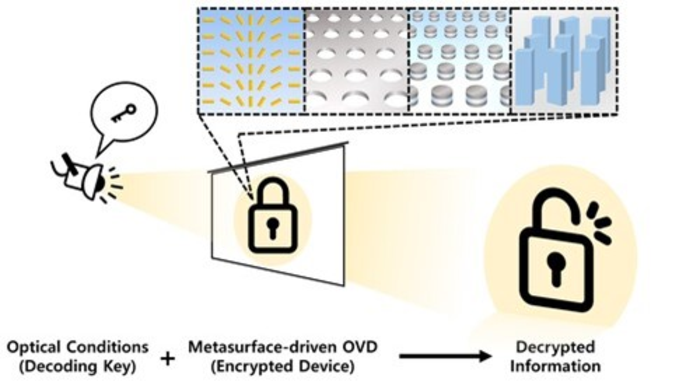The increasing risk of advanced counterfeits always poses a need for a security device that can combat them. A novel technology can be utilized in security devices. However, it is hard to make a comparison of their strengths as no standards were available to quantify their performance.
 A schematic diagram of a security function using the interaction of meta-atoms (information storage device) and light that acts as the key. Image Credit: Pohang University of Science and Technology.
A schematic diagram of a security function using the interaction of meta-atoms (information storage device) and light that acts as the key. Image Credit: Pohang University of Science and Technology.
Hence, Korean researchers, who are pioneers in optical anti-counterfeiting technology based on metasurface — a fully innovative material that freely regulates light — have come up with a new standard.
A group of POSTECH researchers headed by Professor Junsuk Rho (Department of Mechanical Engineering and Chemical Engineering) and Ph.D. candidates Chunghwan Jung, Jaehyuck Jang (Department of Chemical Engineering), Gyeongtae Kim and Minsu Jeong (Department of Mechanical Engineering) have summarized and reported several optically variable devices (OVDs).
This was achieved as per their data capacity and security level. An OVD is primarily utilized for anti-counterfeiting and is a tinfoil-like sticker that alters its color and shape based on the angle of incidence.
The study outcomes were reported as the front cover paper and research highlight in the November 1st issue of Chemical Reviews, a leading journal in the field of nanotechnology. Published by the American Chemical Society, Chemical Reviews is an academic journal that presents study trends and prospects by leading researchers in the field and is known to have as much impact as the journals Nature and Science.
The rainbow hologram sticker is a standard OVD that alters its color based on the angle and is extensively utilized to detect counterfeit bills and for corporate security labels. But the threat of counterfeiting lasts as it is easy to make and can only store little data.
Several devices, such as color conversion inks that alter their colors upon being moved and fluorescent inks that discharge light upon being irradiated with ultraviolet light, have been designed. However, their ineptitude to encrypt complicated data has impeded their extensive applicability.
Therefore, Professor Rho’s group concentrated on the metasurface that regulates light by organizing nanostructures. The thickness of nanostructures is one-thousandth that of a human hair strand — in a preferred shape.
The metasurface-based optical device has the ability to store over 100 times more data compared to the traditional rainbow hologram sticker and can selectively display a preferred image based on the color, angle and polarization.
It is impossible to decrypt the encrypted data without the proper optical decryption. Hierarchical encryption of data enables individual storage of images that can be seen without unique equipment for the untrained eye and images that can only be viewed with particular analysis equipment by security professionals
This device can be easily stored due to its very small size and can be mass-produced at an affordable price. The metasurface technology holds immense potential to extend into new areas of application such as optical counterfeit and forgery devices as well as lidars and ultra-thin lenses.
Security labels made using metasurfaces are difficult to replicate and are highly secure since they cannot be decrypted without specific settings. This study is significant in that it systematically summarized the core principles and applications of metasurface-based security devices led by a Korean research team.
Junsuk Rho, Professor, Pohang University of Science and Technology
This study was performed with financial support from the Samsung Research Funding & Incubation Center for Future Technology.
Journal Reference:
Jung, C., et al. (2021) Metasurface-Driven Optically Variable Devices. Chemical Reviews. doi.org/10.1021/acs.chemrev.1c00294.